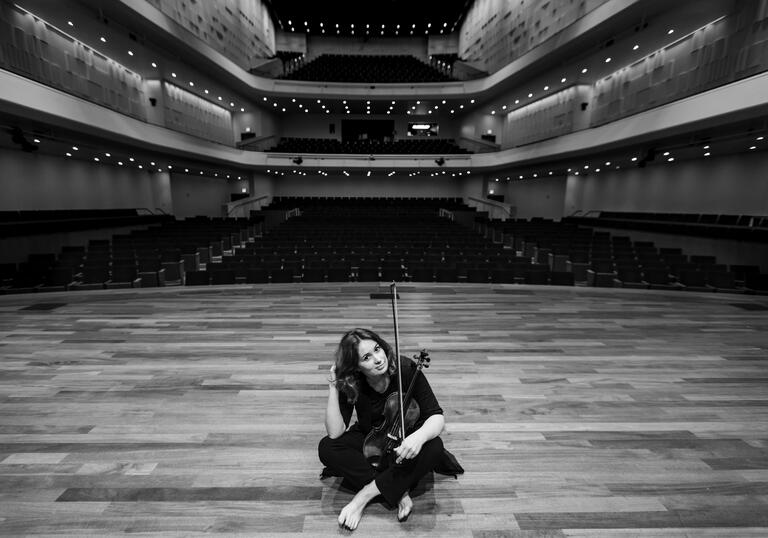The 20th century’s most notorious musical modernist, Arnold Schoenberg, still has the power to unsettle and challenge today, seven decades after his death. But once you get past the shock impact of his more radical works, a world of delicious nocturnal fantasy, tenderness and humour opens up. The brief Phantasy, Op 47, is a prime example. After a spiky, arresting beginning, the writing gradually slips into more dreamlike territory, haunted by ghosts of very late Romantic gestures, but the end is pure Expressionist bravura. The relationship between the violin and the piano is so close and intimate that it’s a surprise to learn that Schoenberg wrote the violin part first, then added the piano when it was complete. It was composed in 1949, for the violinist Adolph Koldolfsky, one of the very few musicians whose understanding of his music Schoenberg trusted. The violin writing is very difficult, but in its weird, wild way it is violin music par excellence.
Schoenberg’s pupil Anton Webern didn’t simply follow his teacher’s lead, he set off into even stranger, more rarefied regions. His works are intensely concentrated, so that these Four Pieces (1910) play for barely five minutes in total. Every tiny phrase, sometimes even a single note, is charged with meaning, and despite some loud interjections, most of the writing is hushed (the marking ‘barely audible’ appears three times on one page). Silence is one Webern’s most potent expressive tools, so much so that it’s difficult to tell where the third and fourth pieces actually end. In a preface to the published score of the slightly later Six Bagatelles for string quartet, Schoenberg wrote that this was music that could ‘express a novel in a single gesture, joy in a single breath’.
In 1950 the American composer Morton Feldman heard a performance of Webern’s Symphony, Op 21, in New York; he was entranced by its exquisite economy of texture and expression. But he was also disgusted at the audience’s mocking reaction. Fleeing the hall, he met the experimental composer John Cage, who had had exactly the same reaction, and the two men became firm friends. Cage’s response, two years later, was his entirely silent piece 4’33”. Feldman’s – immediately after hearing that concert – was this Piece for violin and piano. Like much of Feldman’s later music, it’s mostly quiet, and the impact of Webern’s intoxicating musical asceticism can be felt throughout.
After hearing one of Beethoven’s last major works, the Grosse Fuge (‘Grand Fugue’) for string quartet, Igor Stravinsky described it as ‘an absolutely contemporary piece of music that will be contemporary forever.’ Beethoven’s violin sonatas, on the other hand, sound more specifically like products of the very beginning of the 19th century, poised between Classical elegance and more unstable Romantic impulse. Yet here too, revolutionary stirrings can be found. The Sonata No 7, the second of his three Op 30 set, is double-faced in another sense too. The dark key of C minor is often associated in Beethoven’s music with intense heroic struggle, and there is indeed a dark urgency about some of the writing here, especially the dramatic first movement. But after the songful Adagio comes a puckish, joyously playful Scherzo. It’s said that Beethoven came to regard this movement as ‘incompatible’, but the source (Beethoven’s biographer Anton Schindler) is notoriously unreliable, and in any case it helps set up the tantalisingly ambiguous finale: is this music as serious as it pretends to be, or is there a comic face behind the tragic mask?
His Ninth Sonata, the so-called Kreutzer (1803), is still more forward-looking. Its still-popular nickname actually belongs in the category of great musical injustices. Beethoven did ultimately dedicate the piece to the famous virtuoso Rodolphe Kreutzer, but he hated it and refused to play it. The sonata was, both in fact and in spirit, written for a remarkable British violinist-composer of African descent named George Bridgetower. Beethoven was hugely impressed with Bridgetower, and for a while the two men were good friends – but then Bridgetower apparently insulted the honour of a woman Beethoven admired, and in rage he rescinded the dedication. It seems the memory of Bridgetower sightreading the sonata brilliantly at its premiere was now totally expunged. The original dedication read: ‘Mulatto sonata, composed for the mulatto Brischdauer [sic], great madman and mulatto composer’, and something of that ‘madness’ can be heard in the volcanic first movement, especially in the Presto main section that follows the brief, tentative introduction. This music later made such a powerful impression on the novelist Leo Tolstoy that he made it the trigger for a passionate adulterous affair in his novella The Kreutzer Sonata.
After the wild adventure of the Presto the variation-form second movement seems a step back in time, with an 18th-century elegance to it. But then comes the finale, an intoxicating jig-like movement with the extraordinary energy that you find in many of Beethoven’s dance finales. Near the end, a couple of teasing reminders of the second movement’s good manners are brusquely dismissed. Charismatic madness has won.
© Stephen Johnson

